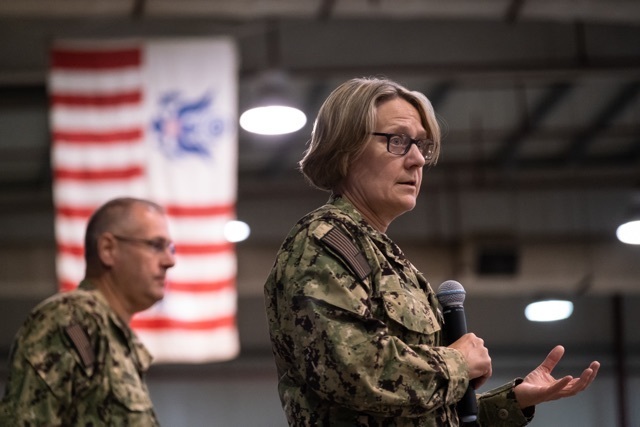
MANAMA, Bahrain — U.S. Coast Guard Patrol Forces Southwest Asia (PATFORSWA) conducted a change of command ceremony on Thursday, June 16 at Manama, Bahrain, as Capt. Eric Helgen relieved Capt. Benjamin Berg.
Presiding over the ceremony was Adm. Linda Fagan, Commandant of the Coast Guard.
“PATFORSWA has a unique area of operations and mission,” Fagan said. “The cutters homeported here are attached to Commander, Task Force 55 to support U.S. Naval Forces Central Command and Combined Maritime Forces strategic objectives. They provide a constant and reliable presence to maintain maritime domain awareness, deter acts of maritime piracy and smuggling, protect critical maritime infrastructure, and ensure the safe flow of goods and materials. There is no other Coast Guard unit that has a stronger link to the joint force in support of the national defense mission.”
Fagan said the cutters have participated in many high-impact operations. “They were on scene for tense boardings of commercial vessels; they navigated interactions with the Iranian Revolutionary Guard Corps Navy; and they conducted extensive interdiction operations.”
Fagan recognized the 110-foot Patrol Boats that served in PATFORSWA. “Adak, Aquidneck, Maui, Monomoy and Wrangell stayed on mission to the very end with operations in the Arabian Gulf and Gulf of Oman.”
One remains, USCGC Baranof, which will be decommissioned soon. “The Baranof is out conducting critical missions as we speak,” Fagan said.
The 110-foot patrol boats are being replaced by the new Fast Response Cutters. “Taking the baton from the 110s, the Fast Response Cutters have proven to be an exceptional platform to project the Coast Guard’s regional expertise to national and coalition forces,” said Fagan.
The four FRCs now in PATFOR SWA are USCGC Charles Moulthrope (WPC 1141), USCGC Robert Goldman (WPC-1142), USCGC Glen Harris (WPC 1144) and USCGC Emlen Tunnell (WPC 1145). Two more FRCs, USCG John Scheuerman (WPC 1146) and USCGC Clarence Sutphin (WPC 1147) arrive in PATFORSWA soon.
While operating with CTF-150, a task force within the Combined Maritime Forces, newly reporting FRCs conducted boardings in the Gulf of Oman that resulted in seizures of heroine, methamphetamine and hashish with a U.S. street value of 17 million dollars.
PATFORSWA provides shoreside teams to support the cutter crews with antiterrorism/force protection, naval engineering, supply and personnel administration along the way. Training teams also support the Navy and partner nations. The Advanced Interdiction Teams embark on the U.S. warships to conduct boardings and seizures of illicit cargos. Several months ago, AITs aboard USS Tempest and USS Typhoon seized 1,400 AK-47 rifles and 226 thousand rounds of ammunition from a stateless fishing vessel in the North Arabian Sea.
“That illegal arms shipment would have contributed to violence and instability in the region had it reached its destination,” Fagan said.
“Any illegal activity at sea — whether it is drug smuggling, weapons shipments, or illegal, unreported or unregulated fishing — erodes the rule of law and regional stability,” Fagan said. “The United States Coast Guard is the global model for maritime governance, the positive force that protects maritime safety, security and economic prosperity.”
Critical Partnerships
In today’s connected world, maritime governance is a collaborative effort. Fagan said partnerships are critically important.
“PATFORSWA leads the way with international engagement throughout the region. The Maritime Engagement Team supports CENTCOM’s theater campaign plan through participation in multi-lateral, interagency exercises and subject matter expert exchanges with foreign militaries. This year the team engaged with more than 350 people from 16 partner nations, sharing expertise on boarding tactics and small boat operations,” she said.
And the Shoreside team contributed in this area, too. “In addition to supporting the 110s and FRCs, they provided electronics and engineering assistance to the Yemeni Coast Guard, and the Lebanese Armed Forces – Navy, a critical 5th Fleet partner who will soon receive three 87-foot Coastal Patrol Boats.”
Additionally, the Shoreside team deployed 25 people for three weeks of support to Operation Allies Refuge, the DoD and DHS operation to safely vet, protec, and transport more than 7,000 evacuees from Afghanistan to Bahrain.
“They were the first people the non-combat evacuees encountered on the flight line after arriving direct from Kabul,” Fagan said.
Helgen is reporting from the 7th Coast Guard District in Miami where he served as the deputy of the Office of Maritime Enforcement.
“I’m exceptionally honored and deeply humbled to have the opportunity to be part of a team whose members sacrifice a year away from their families to execute such a vital mission in support of the United States,” Helgen said.
“PATFORSWA excelled under Captain Berg’s leadership because this crew trusted him, they responded to his vision and leadership, and they rose to the challenge,” said Fagan.
“It has been my absolute pleasure to serve with the outstanding Coast Guard women and men of Patrol Forces Southwest Asia. The dedication and professionalism was evident in every patrol, repair and forward deployment,” Berg said. “I’m certainly pleased of the operational accomplishments of our cutters, crews and partner nation engagements, but I was more energized each day to observe the crews taking pride knowing their work was bringing stability and rule of law to the region.”
- A Day to Remember - September 11, 2023
- Indo-Pacific Maritime Security Exchange will examine emerging capabilities and capacity - July 12, 2023
- Cold Waters Spark Warm Relationship - April 20, 2023






